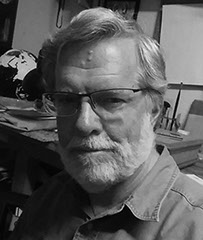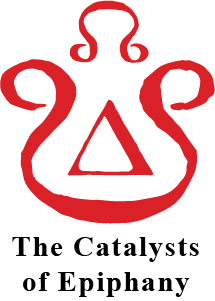Clayton Moraga
Californian (1960 - )
The Artist:
Art decays or is destroyed.
I am compelled to explore how the experience of art can be perpetuated through time.
Ideas are as persistent as a shadow cast by smoke.
I am haunted by the mystery of this ephemeral existence and the brief flame of consciousness.
Beauty arises from the most unexpected places.
I savor the delight of its discovery when sensitized to being in the big here and the long now.
The Art:
The act of creation:
The exterior is a coalesced idea applied to a catalytic interior that is itself successive submerged layers of manifested concepts.
The action of being:
Just as consciousness is formed through the accretion of awareness, thought, and memory; the work becomes an evolving identity through the shifting narrative of appearance and the ongoing evolution of the interior through imagination and fading memory.
Themes
- Consciousness and memory - the “Ba”1 of the artist is not instantly evident, indurate, or frozen in time - and art formulated with depth and duration embedded in its concept and manifestation carries a portion of the existence of the artist, but not as a static monument.
- A state of mind best expressed in the Japanese term, “Mono no aware”, to become sensitized to the transience of things - such as beauty’s erosion, fading associated memories, and the ephemerality of life and awareness.
- The Hiddenness of Interiority whereby a significant portion of the sculpture is not visual but implied by the surface. A surface whose removal or alteration irrevocably changes the experience of the sculpture. The viewer is challenged to preserve an emotional tension that can be expressed as the following: Sustained sense of possibility. Anticipation of discovery. Constant arousal of curiosity. Perpetual imaginative visualization. Seductive threshold of exploration.
- Ablative layers to provide a gradual reveal of concepts over time, an adaptation to, rather than a denial of, the realities of decay. Encasement expressing storage, protection and travel to communicate the state that much art exists in, while commanding its identity outside of a static, passive, guarded environment such as a gallery or museum. It enters into the “real” world as opposed to the world of art as precious objects separated from the flow of life; inanimate yet aware of its vulnerability and impermanence.
- Combinatorics, which is to take a limited set of characteristics and explore the possibilities within innate, or conceptualized, constraints.
Inspiration
- “The Preserving Machine”: A short story by Philip K. Dick, Magazine of Fantasy and Science Fiction, June 1953.
- The Archimedes Palimpsest: An example of a phenomenon where a concept is preserved through a time of social disruption and the destruction or neglect of knowledge by being embedded in a contemporary popular work, only to be discovered when society recovers.
- The Tansu: Storage furniture originally built solely for practical reasons but became over time a beautiful expression of art and craftsmanship - which has helped to preserve them.
- Cryptography: A system whereby a clear and unambiguous message is manipulated into a form that in its most ideal state is entirely undetectable except for a single, precise method for unraveling the content - nothing obscured, added or removed - yet perfectly hidden. The One Time Pad being its most perfect expression where information is simultaneously preserved and forever lost.
- The Long Now Foundation: A fellowship that inspires me and validates the concepts I explore in my work. When I discovered and joined them some time ago it felt like returning home to a country I never knew I had been lost from.
- The Labyrinth: designed to sensitize a person to the present moment and their interior condition through an experience contradictory to the normal routine. The Labyrinth renders urgency and destination absurd in a sublime expression of time and space.
- Mauretania/Mauritania: The ocean liner Mauretania’s dimensions were 232.3m x 26.8m x 18.6m. The country Mauritania’s area is 1,030,700 sq km. The Mauretania is an exemplar for people and cargo in motion; however it quickly became obsolete, was reduced to scrap and now its constituent elements are scattered throughout the world. Mauritania is an arid, lightly populated country whose climate and geography hasn't changed for millennia, yet its conceptual definition is constantly changing. The Mauretania is gone forever and will never change. Mauritania will always be here and will never be the same.
- Piet Hein’s SOMA puzzle: A puzzle where a set number of shapes can be used to create different sculptures. As a child, Moraga worked to create all the puzzle shapes in the included booklet along with a few of his own creation. The fact that some of the shapes in the book looked feasible but were marked as either “proved impossible” or “is it possible?” made it feel to him like an opportunity to participate in exploring unknown territory. An excellent introduction into Combinatorics.
- Howard Carter: The archaeologist who discovered the tomb of Tutankhamun. His dedication to preserving and documenting the tomb’s contents enabled future generations to appreciate the life and creativity of the people of the distant past.
- James Hampton: Creator of "The Throne of the Third Heaven of the Nations' Millennium General Assembly" is inspirational for vision, devotion to beauty, integrity, dedication, and sacrifice.
Moraga is currently in development of a catalytic tool for consciousness sensitization that exploits the receptive attentiveness associated with divination methodology while excluding apophenia. The goal being to develop transilient awareness of Cosmos whereby the experience of epiphanic phenomena, however faint and ephemeral, reveals (to the maximum capacity for human appreciation) sublime truth in beauty.
The Suits for The Stars in the Sea




